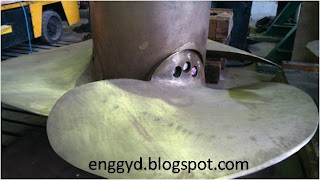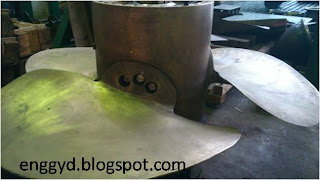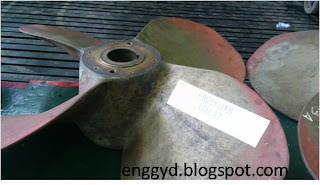Printing Machine and Devices
A printing machine is also known as the printing press, equipment used to print out copies of the original document by means of forcing the inked surface on the belt of the paper or cloth, or polymer sheets. Any form of text or image is imprinted on a series of sheets with perfect dimensions. German Johannes invented the printing press in 1440, and from then this device was modified and redesigned to improve its performance and capacity.
A simple diagram can explain how the laser printer works in your office or home, which is on the principle of static electricity.

Propellers of a ship
Ships use propellers to generate pressure difference and provide motion in the water. Nickel-aluminum bronze alloy is used to make them corrosion-resistant. (80 Cu; 10 Al; 5 Ni; 5 Fe) is an appropriate alloy combination when the propeller is used in seawater. Its coefficient of thermal expansion is 9.4 millionth per Fahrenheit.

The number of blades depends on the capacity and the ship’s masses so that enough acceleration can be produced from the propulsion system. For heavy loads and high speeds, the blades are bolted rather than direct welding to the shaft hub.

A four-blade propeller model shown here is categorized by direct welding the blades to the shaft hub rather than bolting. Such a model is preferred only for low-speed and medium-capacity ships. The word propeller is used for ship-driving systems because they make the fluid flow in the axial direction. The shape of the blades is one of the important identities of the propeller which looks entirely different from turbines and anchors. The angle of the blades is always less than 90 degrees.

Types of Agitators
Propeller agitators are commonly made of three-bladed attached to the main shaft. They are flexible in operations and mostly used in the mechanical mixing of low to medium-viscosity fluids. These types of propellers are also called marine-type propellers. The diameter of the propellers depends on the rotational speed and diameter of the batch reactor or the agitator’s vessel. Depending on the agitator vessel size and the fluid viscosity the power consumption of the propeller agitator may exceed more than 50kW.
Turbine impellers operate at low speeds and are much larger than propellers. A turbine has an excellent feature in designing the flow pattern where a change in design can divert the flow pattern of fluid by radial flow or axial flow in the reactor vessel. Based on the configuration of the impeller blades these flow patterns can be achieved. The radial design makes the fluid flow at high velocity in a radial direction whereas axial impellers use pitched blades, making the fluid flow parallel to the shaft in the downward direction and then push the fluid toward the wall of the agitator’s vessel. For gas dispersion operation radial turbine impeller is used and an axial turbine impeller is used for chemical reactions, suspension solid, and miscible liquid mixing.
Types of agitators models, application, and comparison:
| Agitator models | Application | Advantages | Disadvantages |
| Paddle: Flat paddle finger paddlesGate paddles | Solid mixing slurry mixing | Heavy duty mixingAdjustable to 2 or 4 blades excellent for low-speed | High power consumption efficient liquid circulation |
| Counter-rotating paddles | Paste mixing | Efficient in the laminar condition lending | Vibrates at high speed not suitable for liquid mixing |
| Tumbling | Blending | Paste and viscous material mixing | Not suitable for fluid solutions |
| Disk and cone | Polymers and dispersion preparation | Viscous solution mixing with 60 revolutions per second | Paste mass cannot be handled |
| Free shaft suspension | Sugar processing | Suspension, Thickening operation | High power requirement |
| Impeller type | Emulsion preparations | Good temperature control creates axial flowGood phase mixing | Not for viscous materials |
| Turbine agitator Straight bladePitched bladeVaned diskCurved blade | Liquid and gas reactions | Excellent for dispersion operations creates good radial flow | Only for less viscous liquid below 15 to 20 Ns/m2 |
| Slotted rotary Rotating disk | Powders and cosmetics | Unique particle size and homogeny product formation | Minimum axial flow operates better only for 0.1 to 0.01mm particle size solids |
| Screw Screw in cone | Food and snack processing | Homogenization of highly viscous materials | Not suitable for miscibility operations |
| Helical Ribbon typeHelical screw | Polymer and paints processing | Handles viscoelastic liquids that are more than 20 Ns/m2 | Less radial flow patterns |
| Gate | Blending operations | Good speed control handles pseudoplastic liquids | Not suitable for gas-to-liquid operations |
| Anchor Round anchorCombine anchor and gate | Milk and fat processing | Efficient heat exchange between the reactor walls and reaction mass (fluids) | High power consumption requires heavy-duty gearbox |
| Propeller | Dairy and food processing chemicals processing | Less Metzner –Ott shear rate constantHomogenizationGood miscibility | The motion of liquid starts on one spotted spots formation at high rotation speeds occurrence of solids settling at low speeds |
Related Topic click here
- SULPHATES Determination Test | Sulphites Determination | Determination Of Sulphate And Sulphide In Water
- Petrochemical Products From Propylene | Types Of Pressure Gauges | Types Of Reactors Used For Chemical Reactions And Chemical Process
- Predesulphurization Of Raw Naphtha Process Plant Flow Sheet
- Phosphoric Acid Per Day Flow Sheet Of Dihydrate Process
- Types Of Phenol Manufacturing Process
- Chlorobenzene And Caustic Process For Phenol Production | Phenol Production By Benzene Sulfonation Process
- Bin Blender Applications
- Operating Procedure For Liquid-Liquid Extraction In Packed Column


